At first glance, the cephalopod seems an unlikely muse for steampunk’s retro-futuristic style. These radically unconventional creatures, with their unmistakably alien anatomies and remarkably advanced intelligences, would seem to have little in common with the well-mannered Victorian worldview. And yet, this striking divergence from familiarity has proven precisely why the octopus has become such an iconic representation of the genre’s core principle: to take the known and reimagine it into something strange, wondrous, and new.
Tentacled tributes to Victorian oceanographic obsessions
During the nineteenth century, a fervent cultural fascination took hold with exploring the unexplored depths of the world’s oceans. The era’s naturalists and artists were utterly enthralled by the bizarre, radially divergent life forms that called these inky realms home.
Perhaps no creature piqued the Victorian imagination more than the octopus and its otherworldly cephalopod kin. The obsession was fueled by the spectacular works of pioneering underwater explorers like William Beebe and the revolutionary naturalist illustrations of artists like Ernst Haeckel.
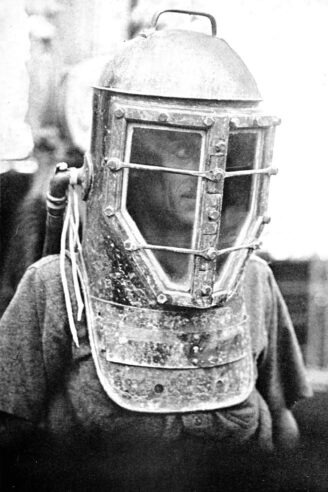


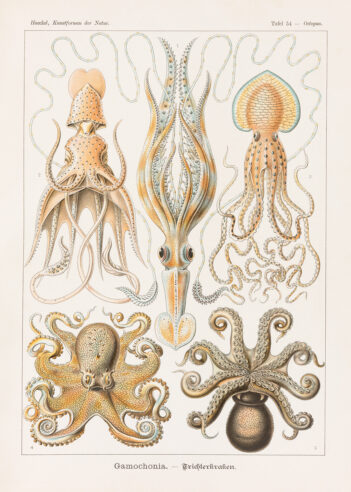
In steampunk, sculptors and artisans breathing new life into these forgotten fixations, the inherent romance and mystique surrounding these enigmatic ocean dwellers was suddenly revived and reimagined through an eccentric maker’s lens.
Intricate anatomical interpretations in metal and machinery
When it comes to manifesting the core steampunk aesthetic of fusing organic naturalism with intricate man-made machinery, no creature has proven more perfectly suited than the octopus. Each steampunk artist brings their own finely-tuned vision and skillset, uniquely rendering the octopus’s muscular, boneless, radially symmetrical physiques in a wild variety of gleaming brass, copper, and antiqued steel media.
Gearworks of graceful, gyrating limbs
Many sculptural interpretations choose to pay direct homage to the octopus’ most famous trait — the remarkable dexterity and fluid, undulating motion of their eight tentacles. These are re-envisioned into tightly coiled tangles of filigreed brass tubing and delicate whirring gearworks all meticulously jointed together. The sight of these cold, unfeeling machinery versions so perfectly mimicking the seamless, boneless grace of real tentacles is at once surreal and utterly sublime.
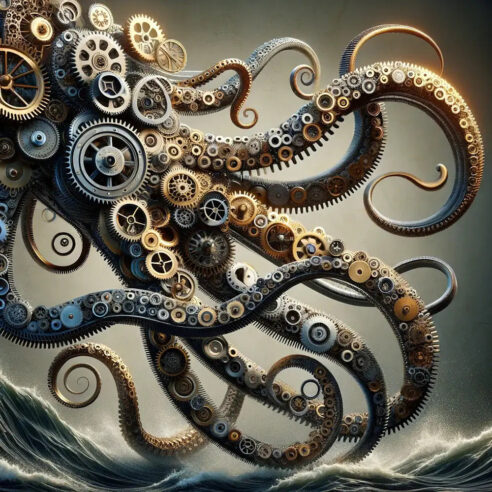
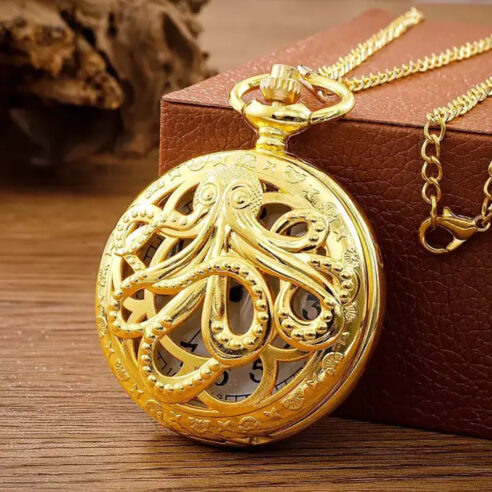
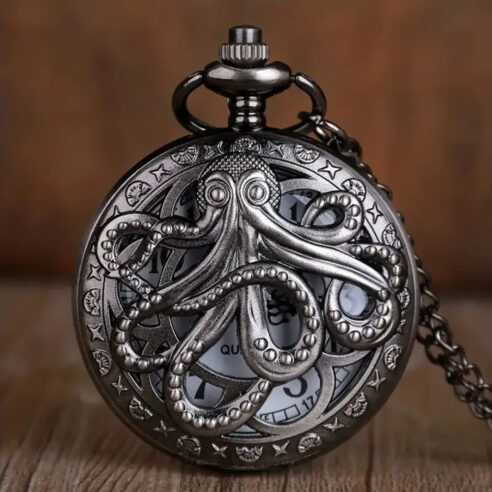
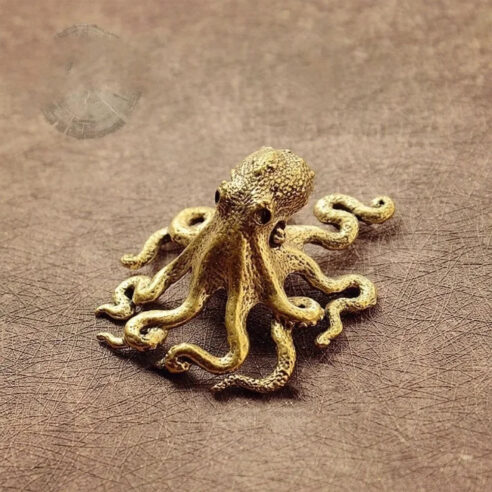
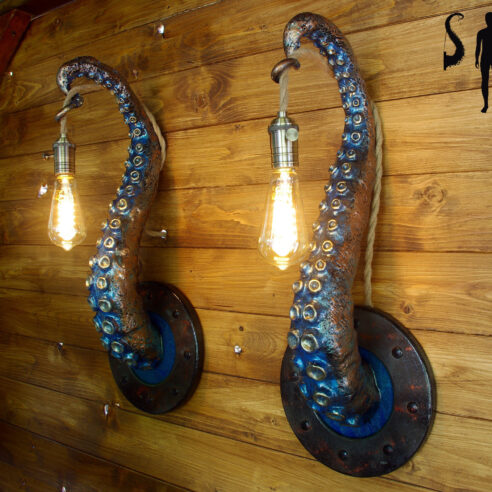
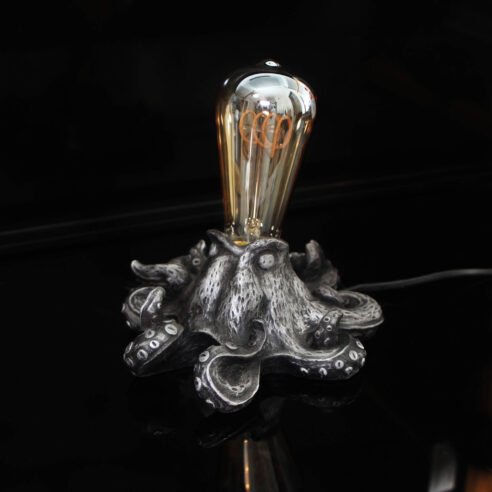
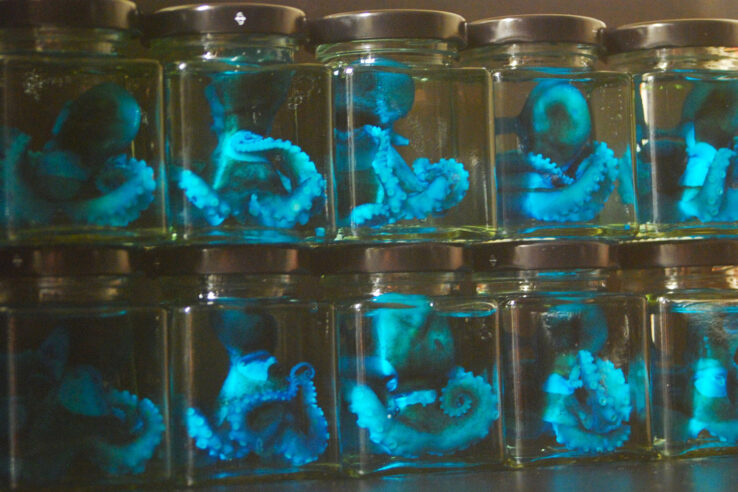
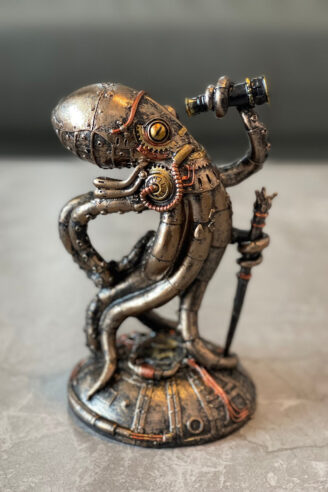
Other artists forgo intricate mechanisms in favor of more free-flowing, organic shaping techniques. Using an array of metalworking methods like repoussé and chasing, they delicately hammer and punch sheets of metal to create octopus limbs that almost appear as soft and pliant as the living creature’s.
Goggled visages and brass-plated beaks
Beyond its signature tentacles, the octopus’ iconic bulbous head has also proven irresistible to steampunk artisans’ wildly unconventional biomechanical design imaginings. Some sculpt whimsical visages with the creature’s trademark horizontal slits for eyes, integrating ornate copper goggles and protruding brass “beaks” to create phantasmagorical nineteenth-century deep-sea diving suits or submersibles. Others envision more eerily organic-mechanical hybrid forms, with iridescent glass eyes peering out from intricately etched bronze and brass cases clearly inspired by the designs of antique diving helmets and vessels. A few sculptors even incorporate functional lighting elements, allowing their octopus constructions’ eyes to illuminate with an eldritch glow.
Beyond sculpture: Unleashing the kraken in diverse media
While the octopus undoubtedly reigns supreme as the preeminent sculptural subject in the steampunk art world, this incredible creature’s strange yet inherently intelligent form has also served as boundless inspiration across myriad other mediums. Seeing these usually humble sea dwellers reimagined into the spectacular and larger-than-life is a true delight.
Illustrative journeys into fanciful marine machinations
In the realm of steampunk-inspired illustration and concept art, a number of renowned artists have taken the octopus as their subject and run wild with it. Brian Engh, Matt Dixon and Kostya-PingWIN have all lent their prodigious talents to render whimsically surreal scenes of towering, kraken-esque iron behemoths thunderously surfacing from the depths.
Others, like Rasmus Andersen, envision more contained, Martha Wells-inspired scenarios — xenobiological laboratories filled with specimen jars containing curious robotic cephalopod creations.
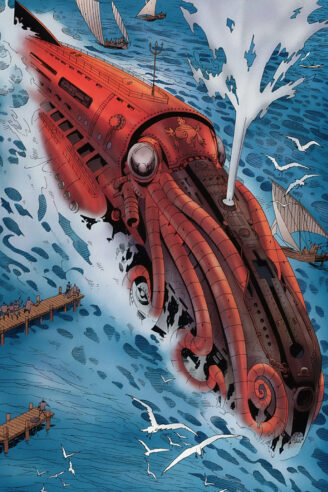



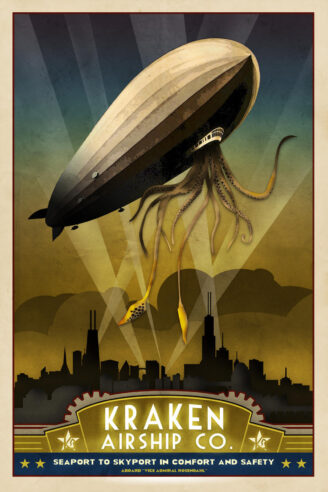
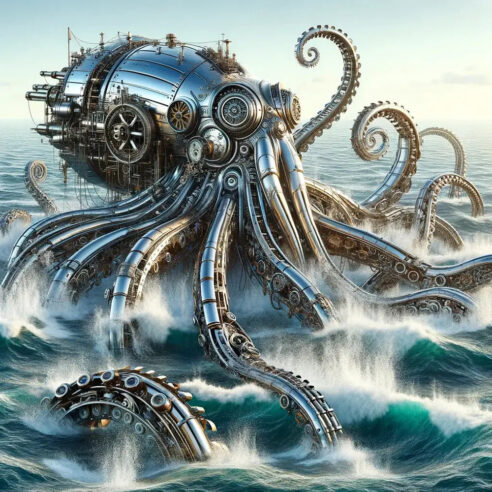
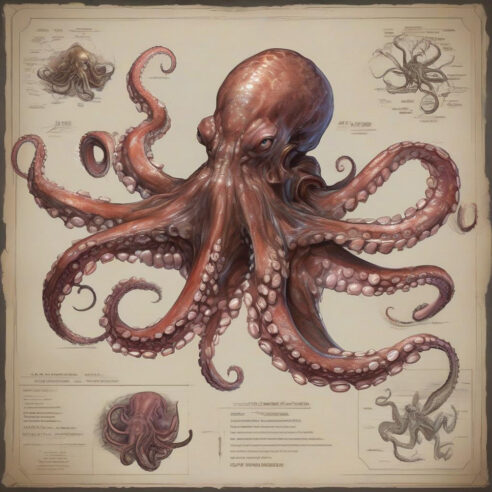
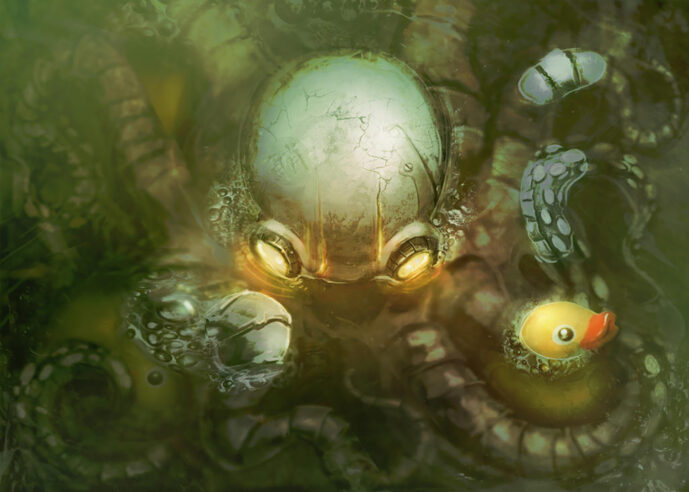

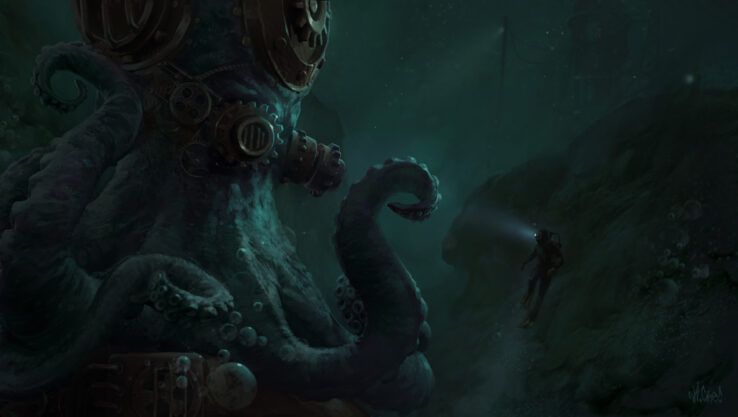
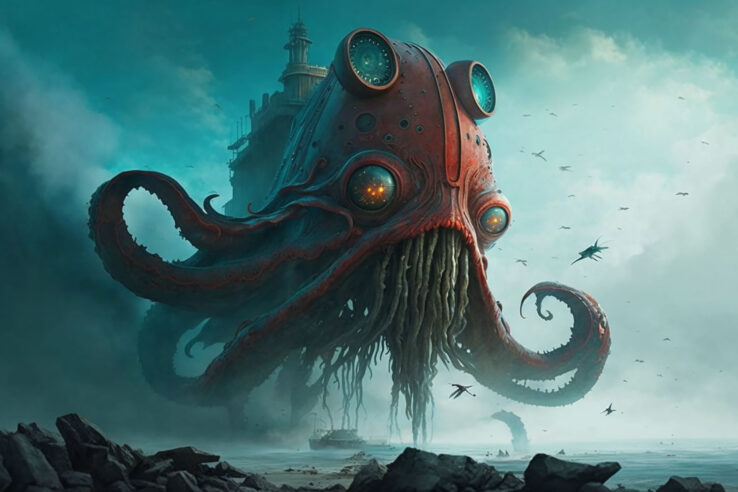
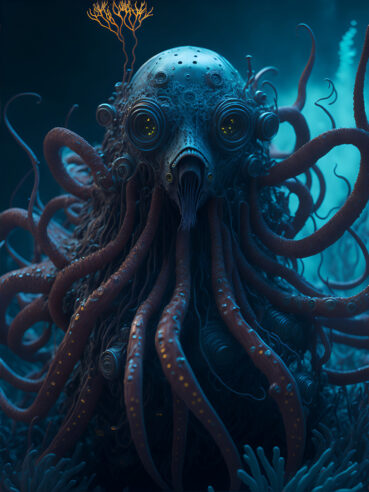
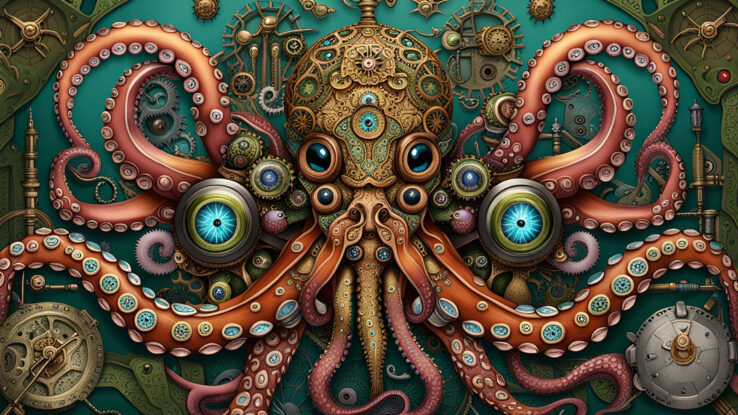

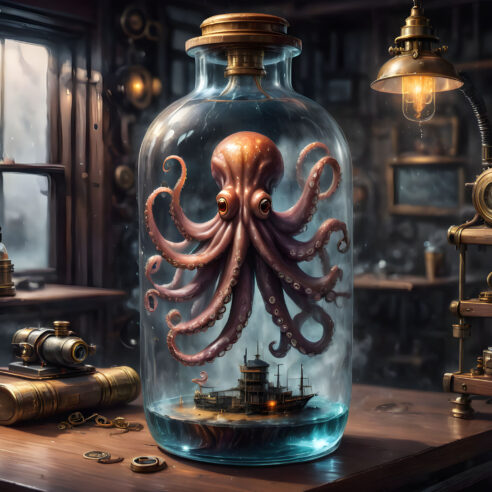
Many artists choose to render their octopus-themed pieces in the style of classic eighteenth- and nineteenth-century naturalist illustrations, cleverly blending decorative Victorian aesthetics with modern biomechanical influences.
3D-printed and posable polymeric polypi
The steampunk octopus has also found innovative new form in the bleeding-edge technological realm of 3D printing and additive manufacturing. Using articulated joint designs, makers have created intricate cephalopod figures whose segmented metal tentacles can twist, undulate and pose in any number of boneless configurations.
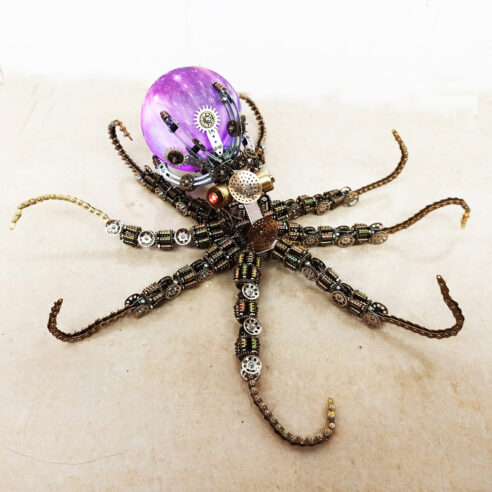
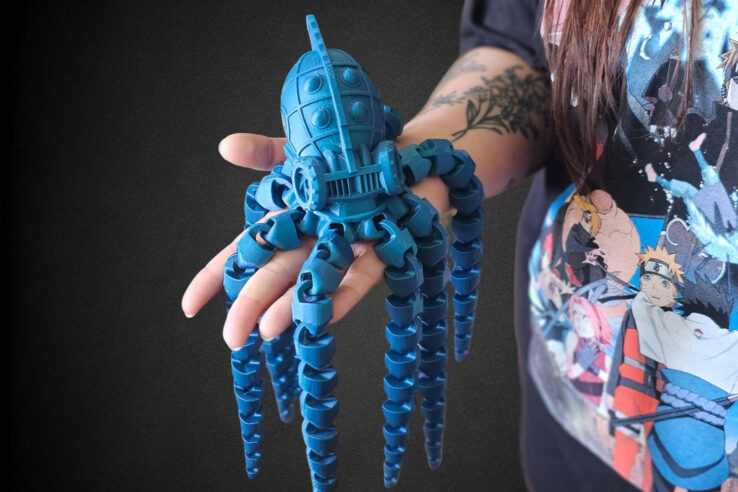
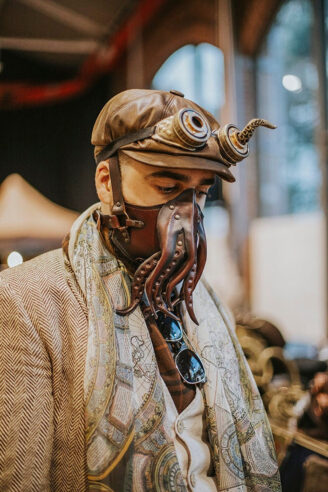
Clothing and accessories adorned With cephalopodic charms
For those seeking to take the eccentric whimsy and industrious spirit of the steampunk octopus wherever they roam, a number of outfitters and artisans have begun incorporating octopus elements into clothing and accessories. Milliners and haberdashers craft hats, goggles and other headpieces with delicately embossed or sculpted brass tentacle flourishes. Clothing makers embroider or etch intricate octopus-themed designs into jackets, cloaks and the like. Even cobblers have gotten in on the fun by etching or sculpting three-dimensional octopus designs into leather shoes, bags, and other accessories.
Clearly this most unconventional of sea creatures has more than proven its versatility as a unique sartorial signature for any proper steampunk explorer or eccentric.
Why the octopus endures as an industrial innovators’ muse
As we’ve explored, the octopus has undeniably become one of the most ubiquitous and enduring iconographic symbols across the steampunk art world. But just what exactly is it about this most unconventional of creatures that has solidified its place as a cultural emblem representing the entire retro-futuristic aesthetic?
Look closer and it becomes clear the octopus is in many ways a visual metaphor for the larger creative driving ethos behind the steampunk community of makers and innovators. In the octopus’ alien, yet highly intelligent anatomy and unique physiology, artists see aspects of their own creative aims reflected back at them. Just as these creatures radically adapt and repurpose everyday marine resources and materials to meet their own unique biological needs in seemingly impossible ways, so too do steampunks repurpose society’s discarded tools and industrial detritus — gears, pipes, machines and more — for wildly imaginative reinterpretations and alternate purposes.
The octopus’ incredible ability to change both its appearance and texture to blend into its surroundings on a whim is also deeply symbolic of steampunk’s own enduring, hard-to-pin-down, shapeshifting nature. Like the octopus, the very essence of the steampunk movement remains fluid without rigid boundaries. What today may seem offbeat, even freakish to mainstream observers can suddenly become celebrated, chic and avant-garde seemingly overnight.
Even more profound is how the octopus as a species represents determined perseverance against all odds. These intelligent, resourceful beings have thrived across the planet’s oceans for over 300 million years, finding incredible success after surviving one of the greatest mass extinction events in Earth’s history. This tenacious adaptability despite facing immense challenges from an ever-changing world perfectly mirrors the struggles and triumphs of artists pursuing their singular creative visions, sometimes against seemingly insurmountable odds.
For the visionary artisans, engineers, makers and appreciators alike, the steampunk octopus stands as far more than a mere curiosity or offbeat icon. It has emerged as a powerful cultural symbol representing the core ideals of ingenuity, perseverance, and an unquenchable drive to blend the past with visions of an impossibly reimagined future. Within its unique clockwork reinvention beats the endlessly ambitious, limitlessly innovative heart of the entire steampunk movement itself.
This story was originally published at Infinite Steampunk, March 12, 2024.




